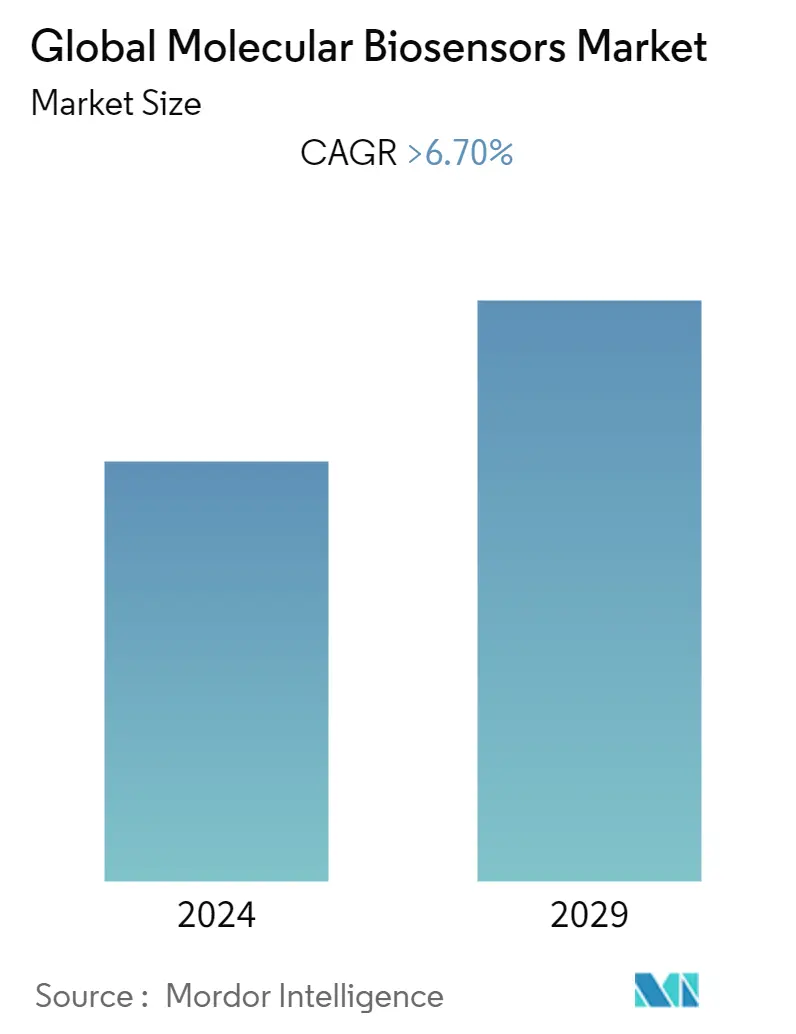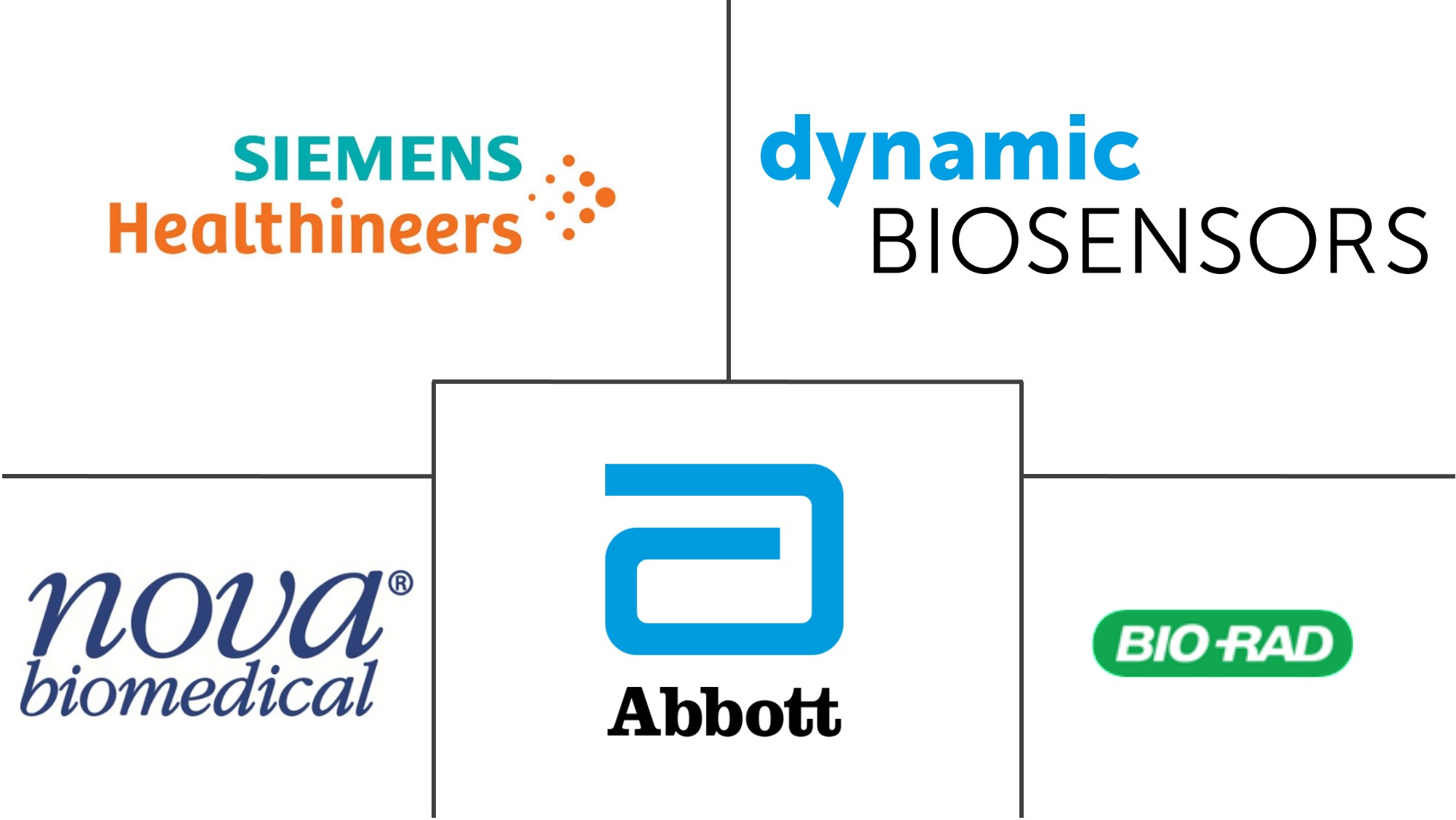Market Size of Global Molecular Biosensors Industry

| Study Period | 2019 - 2029 |
| Base Year For Estimation | 2023 |
| Forecast Data Period | 2024 - 2029 |
| CAGR | > 6.70 % |
| Fastest Growing Market | Asia Pacific |
| Largest Market | North America |
Major Players
*Disclaimer: Major Players sorted in no particular order |
Molecular Biosensors Market Analysis
The molecular biosensor market is expected to grow at a CAGR of 6.7% over the forecast period, 2022-2027.
The current pandemic of COVID-19 is expected to shed light on the molecular biosensors market. As most of the centralized laboratories have been employing Polymerase chain reaction (PCR) testing in the diagnosis of SARS-CoV2 viral infection among suspected patients, there has been a significant delay in the clinical outcomes as PCR testing requires more time for accurate and reliable results. This has paved the way for the application of Point-of-care testing in COVID-19 detection. According to the research article published in the Lancet, Respiratory Medicine, 2020, molecular point-of-care testing has attained significant importance in the detection of COVID-19 infection as these are rapid, when compared to the Polymerase chain reaction (PCR) testing. In this study, the patients who were tested positive for COVID-19 through point of-care testing were recruited to further clinical trials 2 days prior than the other patients who were tested using the PCR technique. Thus, given the need for rapid diagnostics, the studied market is expected to witness significant growth during the pandemic.
In recent years, due to the increasing prevalence of chronic diseases, the demand for point-of-care diagnostics has increased. This has led to an increase in demand for molecular biosensors. The increasing application of molecular biosensors in the detections of various cancers, diabetes, pregnancy, along with wide usage in other fields such as environmental safety, food and beverages, and defense and security plays a vital role in the growth of the studied market over the forecast period. According to the Globocan 2020 fact sheet, an estimated 19,292,789 new cancer cases were diagnosed worldwide, with nearly 9,958,133 deaths due to cancers globally. Additionally, according to estimates from the International Agency for Research on Cancer (IARC), by 2040, the global burden of cancers is expected to grow to 27.5 million new cancer cases and 16.3 million deaths worldwide. Furthermore, the increasing burden of infectious disease surges the demand for molecular point-of-care diagnostics, which in turn drives the studied market.
Worldwide potential as a point of care (POC) market was already growing when the coronavirus focused the country's healthcare system on molecular diagnostics and imaging testing. Point of care diagnostics systems are used for the diagnosis of human immunodeficiency virus, cancers, and hereditary diseases. In addition to suspected infectious cases. The adoption of Point of care diagnostics by various health organization such as Clinton Foundation HIV/AIDS Initiative; Roll Back Malaria; United Nations Programme on HIV/AIDS (UNAIDS); United States President's Emergency Plan for Aids Relief (PEPFAR); the Global Fund to Fight AIDS, Tuberculosis and Malaria; and the WHO increased screening for some of the most burdensome emerging infectious diseases in the developing country. Hence rising the use of molecular biosensor in the point of care diagnosis.
However, high costs involved in research and development and strict regulatory guidelines to be followed for the approval of products by authorities dissuade many manufacturers to enter the market. This is expected to hinder the growth rate of the market over the forecast period.
Molecular Biosensors Industry Segmentation
As per the scope of the report, a molecular biosensor is a device that uses specific biochemical reactions mediated by isolated enzymes, immunosystems, tissues, organelles, or whole cells to detect chemical compounds usually by electrical, thermal, or optical signals and is, thus, able to facilitate rapid detection and diagnosis at the Point-of-Care (POC), which make them particularly useful for an early and unequivocal diagnosis. The Molecular Biosensors market is segmented by Technology (Electrochemical Biosensors, Optical Biosensors, Thermal Biosensors, Piezoelectric Biosensors), Application (Medical Diagnostics, Food and Beverages, Environment Safety, Defense and Security and Others, and Geography (North America, Europe, Asia-Pacific, Middle East and Africa, and South America). The market report also covers the estimated market sizes and trends for 17 different countries across major regions globally. The report offers the value (in USD million) for the above segments.
| By Technology | |
| Electrochemical Biosensors | |
| Optical Biosensors | |
| Thermal Biosensors | |
| Others |
| By Application | |
| Medical Diagnostics | |
| Food and Beverages | |
| Environment Safety | |
| Defense and Security | |
| Others |
| Geography | ||||||||
| ||||||||
| ||||||||
| ||||||||
| ||||||||
|
Global Molecular Biosensors Market Size Summary
The molecular biosensors market is poised for substantial growth, driven by the increasing demand for rapid and accurate diagnostic solutions across various sectors. The COVID-19 pandemic has significantly highlighted the importance of molecular biosensors, particularly in point-of-care testing, as they offer quicker results compared to traditional methods like PCR testing. This shift towards faster diagnostics is further supported by the rising prevalence of chronic diseases, such as cancer and diabetes, which necessitate timely and efficient detection methods. The application of molecular biosensors extends beyond healthcare, finding relevance in environmental safety, food and beverage quality control, and defense and security, thereby broadening the market's scope and potential.
The electrochemical biosensors segment, in particular, is expected to capture a significant share of the market due to its effectiveness in detecting pathogens in liquid biopsies and its suitability for point-of-care applications. The advancements in electrochemical biosensor technology, coupled with its wide application in infectious disease detection, are anticipated to drive its growth. North America, especially the United States, is projected to hold a major market share, supported by high research and development expenditure and the presence of key market players. The market is characterized by consolidation, with major players like Abbott Laboratories Inc., Bio-Rad Laboratories Inc., and Siemens Healthcare leading the charge through strategic alliances and innovations. The emergence of smaller players in the Asia-Pacific region also contributes to the market's expansion, reflecting a growing awareness and demand for molecular biosensing technologies.
Global Molecular Biosensors Market Size - Table of Contents
-
1. MARKET DYNAMICS
-
1.1 Market Overview
-
1.2 Market Drivers
-
1.2.1 Increasing Prevalence of Chronic and Lifestyle Induced Diseases
-
1.2.2 Increasing Demand for Point of Care Testing
-
1.2.3 Increasing Application of Biosensors in Various Industries
-
-
1.3 Market Restraints
-
1.3.1 Strict Regulatory Requirements for Biosensors
-
1.3.2 High Cost Involved in Research and Development
-
-
1.4 Porter's Five Force Analysis
-
1.4.1 Threat of New Entrants
-
1.4.2 Bargaining Power of Buyers/Consumers
-
1.4.3 Bargaining Power of Suppliers
-
1.4.4 Threat of Substitute Products
-
1.4.5 Intensity of Competitive Rivalry
-
-
-
2. MARKET SEGMENTATION (Market Size by Value - USD million)
-
2.1 By Technology
-
2.1.1 Electrochemical Biosensors
-
2.1.2 Optical Biosensors
-
2.1.3 Thermal Biosensors
-
2.1.4 Others
-
-
2.2 By Application
-
2.2.1 Medical Diagnostics
-
2.2.2 Food and Beverages
-
2.2.3 Environment Safety
-
2.2.4 Defense and Security
-
2.2.5 Others
-
-
2.3 Geography
-
2.3.1 North America
-
2.3.1.1 United States
-
2.3.1.2 Canada
-
2.3.1.3 Mexico
-
-
2.3.2 Europe
-
2.3.2.1 Germany
-
2.3.2.2 United Kingdom
-
2.3.2.3 France
-
2.3.2.4 Italy
-
2.3.2.5 Spain
-
2.3.2.6 Rest of Europe
-
-
2.3.3 Asia-Pacific
-
2.3.3.1 China
-
2.3.3.2 Japan
-
2.3.3.3 India
-
2.3.3.4 Australia
-
2.3.3.5 South Korea
-
2.3.3.6 Rest of Asia-Pacific
-
-
2.3.4 Middle East and Africa
-
2.3.4.1 GCC
-
2.3.4.2 South Africa
-
2.3.4.3 Rest of Middle East and Africa
-
-
2.3.5 South America
-
2.3.5.1 Brazil
-
2.3.5.2 Argentina
-
2.3.5.3 Rest of South America
-
-
-
Global Molecular Biosensors Market Size FAQs
What is the current Global Molecular Biosensors Market size?
The Global Molecular Biosensors Market is projected to register a CAGR of greater than 6.70% during the forecast period (2024-2029)
Who are the key players in Global Molecular Biosensors Market?
Bio-Rad Laboratories Inc, Siemens Healthcare, Nova biomedical Corporation, Abbott Laboratories Inc. and Dynamic Biosensors GmbH are the major companies operating in the Global Molecular Biosensors Market.

